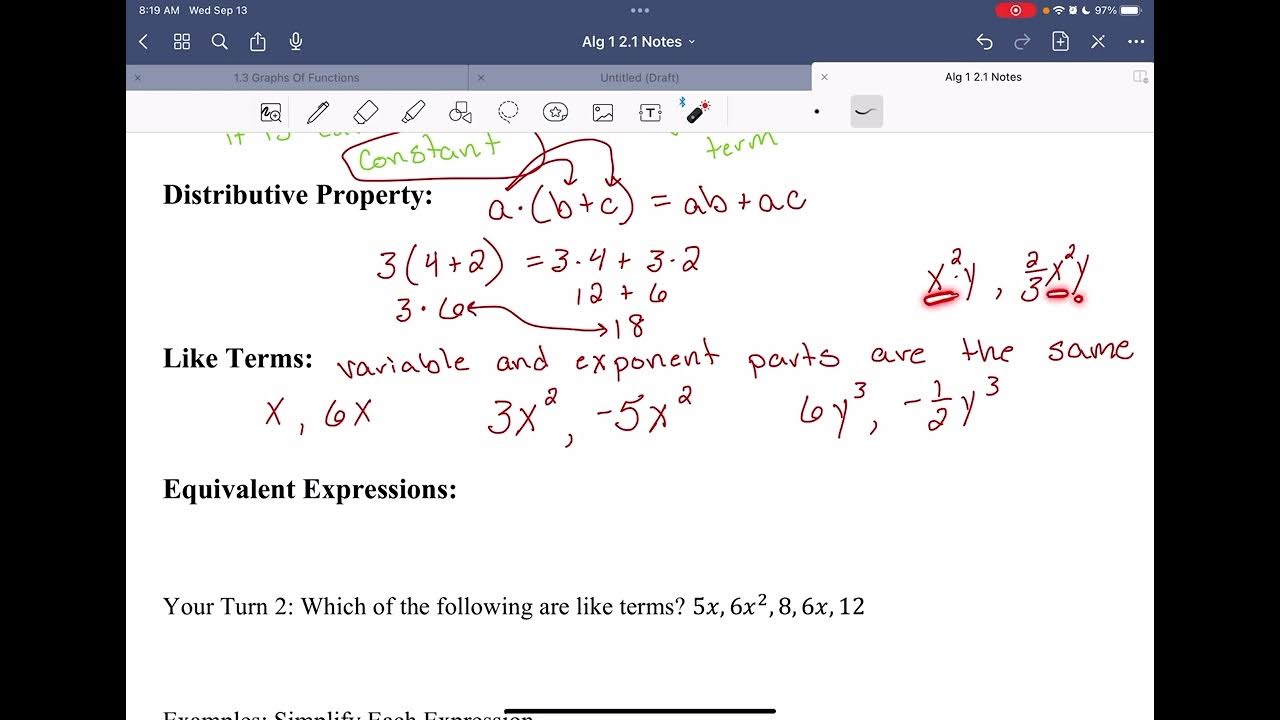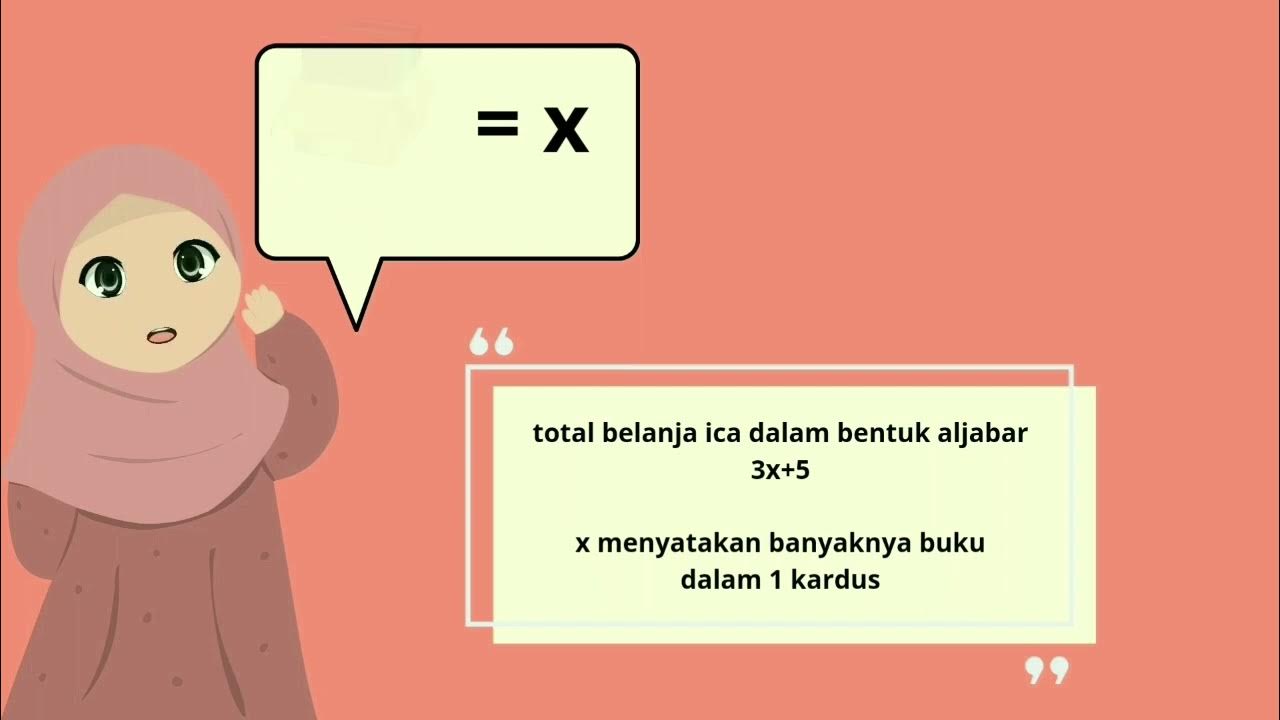TRANSLATING WORDS INTO ALGEBRAIC EXPRESSIONS!
Summary
TLDRThis lesson focuses on translating written expressions and equations into algebraic form using numbers and variables. The video explains key terms like 'sum,' 'more than,' 'less than,' and 'product,' demonstrating how to represent these mathematically. It highlights the importance of variables, parentheses, and switch words like 'then' in translation. Through examples, viewers learn to convert phrases such as '10 plus a number' and 'the difference of six and a number' into numerical expressions. The video concludes with a lighthearted math joke and encourages viewers to practice for better understanding.
Takeaways
- 📚 The lesson focuses on translating written algebraic expressions and equations into numerical form using variables.
- ❓ Variables like 'X' represent unknown values, and the letter used is interchangeable with any alphabet letter.
- ➕ Addition expressions like '10 plus a number' translate to '10 + X', where 'X' is the variable.
- 🔄 For phrases like '10 more than a number', the order changes, and the translation becomes 'X + 10'.
- ➖ When subtraction is involved, such as in '6 less than a number', the translation switches to 'X - 6'. The word 'then' signals a switch in order.
- ✂️ Subtraction examples, like 'the difference of 3 and a number', translate to '3 - X'. Complex expressions may need parentheses.
- ➗ Division, such as 'a number divided by 3 is 8', translates to 'X / 3 = 8', with 'is' representing equals.
- ✖️ The product of numbers or variables, like 'the product of a number and 9', translates to '9 * X' or '9X'.
- ➗ Expressions like 'half a number decreased by 12' are represented as 'X / 2 - 12'.
- 🏁 The lesson concludes with a reminder to practice translating phrases into algebraic expressions and equations for better understanding.
Q & A
What is the primary goal of this algebraic translation lesson?
-The primary goal of the lesson is to teach students how to translate written expressions and equations into numerical form using numbers and variables.
How would you translate '10 plus a number' into an algebraic expression?
-'10 plus a number' translates to the algebraic expression 10 + x, where x represents an unknown number.
How does the phrase '10 more than a number' differ from '10 plus a number' in algebraic terms?
-'10 more than a number' translates to x + 10, where the variable comes first. While both involve addition, 'more than' suggests the number comes before the 10.
How do you interpret the phrase '6 less than a number' algebraically?
-'6 less than a number' translates to n - 6. The phrase uses 'less than,' which means subtraction, and the order is reversed, with the variable coming before the 6.
What does the word 'then' signal in an algebraic translation?
-The word 'then' signals a switch in the order of terms. In expressions like '6 less than a number,' it indicates that the second term (the variable) comes before the first term (6).
How would you translate 'the difference of three and a number'?
-'The difference of three and a number' translates to 3 - p, where the word 'difference' indicates subtraction and 'p' represents the unknown number.
How should you handle parentheses when performing algebraic translations?
-Parentheses are used to separate independent groupings in algebraic translations, especially when multiple operations are involved. For example, 'the difference of a number and twice a number plus one' would be written as n - (2p + 1).
What does the word 'is' signify in algebraic expressions?
-In algebraic expressions, the word 'is' signifies equality and is represented by the equal sign (=). For example, 'a number divided by 3 is 8' would be written as t/3 = 8.
How do you translate 'three times the difference of a number and one'?
-'Three times the difference of a number and one' translates to 3 * (p - 1), where the expression inside the parentheses (p - 1) represents the difference, and it's multiplied by 3.
How do you translate '20 times a number less than two'?
-'20 times a number less than two' translates to 2 - 20y. The word 'less than' indicates subtraction, and since 'then' is a switch word, the order of the terms is reversed.
Outlines

此内容仅限付费用户访问。 请升级后访问。
立即升级Mindmap

此内容仅限付费用户访问。 请升级后访问。
立即升级Keywords

此内容仅限付费用户访问。 请升级后访问。
立即升级Highlights

此内容仅限付费用户访问。 请升级后访问。
立即升级Transcripts

此内容仅限付费用户访问。 请升级后访问。
立即升级浏览更多相关视频

Translating Real-life Situations to Algebraic Expressions | 1st Quarter Grade 8 Matatag Revised K-12

What is an Equation? | Don't Memorise

All Of Algebra Explained In 15 Minutes

Alg 1 2.1 Part 1 Write, Interpret, and Simplify Expressions

Materi Aljabar Kelas 7

Pemfaktoran Suku Bentuk Aljabar - bagian 2 💡Pasti Bisa
5.0 / 5 (0 votes)
